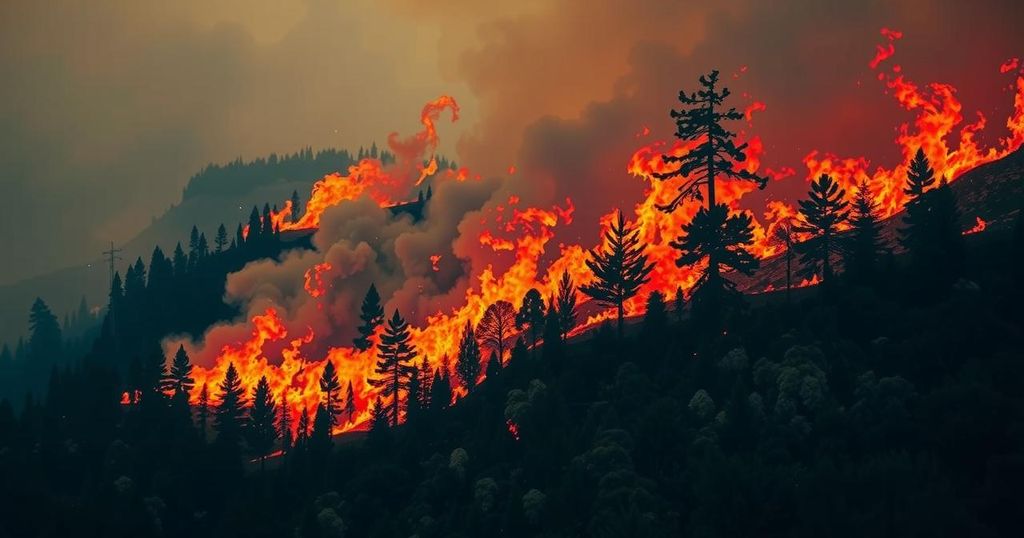Research Reveals Global Increase in Wildfires Attributable to Climate Change Despite Human Interventions
Recent studies reveal a robust link between climate change and the rising incidence and severity of wildfires, leading to a dramatic increase in smoke-related deaths. Research indicates that annual wildfire smoke-related fatalities rose from under 669 in the 1960s to approximately 12,566 by the 2010s. While some regions showed a decline in wildfire occurrences due to human activity, others such as California and Siberia experienced significant increases attributed to climate change. The findings emphasize the urgency for immediate action to address greenhouse gas emissions and improve fire management strategies.
Recent research indicates a significant correlation between climate change and the rising frequency and severity of wildfires globally, coinciding with a troubling increase in mortality from smoke inhalation. Two independent studies conducted by research groups from Dalhousie University, Belgium, the United Kingdom, and Japan have revealed alarming trends in wildfires and their detrimental effects on human health. It was estimated that annual wildfire smoke-related deaths increased dramatically from under 669 in the 1960s to approximately 12,566 by the 2010s. One of the studies published in Nature Climate Change analyzed wildfire models with and without climate change effects, revealing widespread increases in wildfire occurrences and intensities across various regions, notably sensitive ecosystems in African savannas, Australia, and Siberia. However, geographical variations were evident; in Africa, which accounts for up to 70 percent of the global burned area, a significant reduction in wildfires was attributed to heightened human activity and land segmentation that impedes fire spread. In contrast, forested regions such as California and Siberia observed a notable rise in fires, primarily driven by prolonged drought conditions and elevated temperatures associated with climate change. Dr. Sian Kou-Giesbrecht, an associate professor in Dalhousie’s Department of Earth and Environmental Sciences, emphasized the significance of the findings, stating the studies quantify climate change’s contribution to increasing wildfire incidents around the world and their societal impacts. Utilizing models that encompassed various influencing elements including climate, vegetation, and population density, the research teams remarked that while certain human interventions, such as fire suppression and landscape management, can mitigate fire spread, these measures fall short against the robust impacts of climate change, especially during periods of extreme weather. “What is striking is that in periods with low to moderate numbers of fires, direct human interventions have a large effect. However, in periods with many fires, the effect of climate change dominates, meaning that in these cases we lose control,” stated Seppe Lampe, a climate scientist at the Vrije Universiteit Brussel, and a lead author of the study. He further noted that despite efforts to reduce the area burned, climate change’s influence continues to escalate. The simulations revealed that global burned areas heightened by nearly 16 percent from 2003 to 2019, with an increased probability of encountering months with above-average burned areas by 22 percent. Notably, the contribution of climate change to the global burned area increased by 0.22 percent each year, with Central Australia experiencing the most significant rise. Another publication, also released that same day, underscored the escalating toll of wildfire smoke on public health, indicating a tenfold increase in smoke-related deaths over the past five decades. This study involved researchers from the National Institute for Environmental Studies in Japan and employed a fire-vegetation model along with a chemical transport and health risk assessment model, finding that while only one to three percent of fire-related deaths in the 1960s were linked to climate change, this figure jumped to 28 percent by the 2010s across varying models. The regions of South America, Australia, Europe, and the boreal forests of Asia faced the most significant mortality rates. Dr. Kou-Giesbrecht noted the complexities involved in attributing specific wildfires to climate change due to numerous variables, yet insists their research demonstrates a strong link. She cautioned that if current climate change trajectories persist, the area subject to wildfires and the associated health risks are likely to surge in future decades. “We also put this into context by quantifying the human mortality associated with intensifying wildfire smoke,” she concluded.
The backdrop for this research is the ongoing crisis of climate change, which has profound implications for environmental and public health. As global temperatures rise and weather patterns shift, the frequency and intensity of natural disasters, particularly wildfires, have escalated. Wildfires not only endanger ecosystems but also pose significant risks to human health through smoke exposure, which has become increasingly fatal over recent decades. These studies address the critical need to understand the interplay between human activity, climate change, and wildfire occurrences to formulate effective prevention and mitigation strategies.
In summary, the research underscores the troubling link between climate change and the increasing prevalence and severity of wildfires worldwide, highlighting the corresponding rise in smoke-related health risks. While human intervention mechanisms such as fire suppression may mitigate some of these impacts, they have proven insufficient in counteracting the overarching influence of climate change in extreme years. Immediate and comprehensive greenhouse gas emission reductions, alongside strategic landscape and fire management interventions, are deemed vital to curtail the detrimental effects of wildfires on both human populations and ecosystems.
Original Source: www.dal.ca




Post Comment